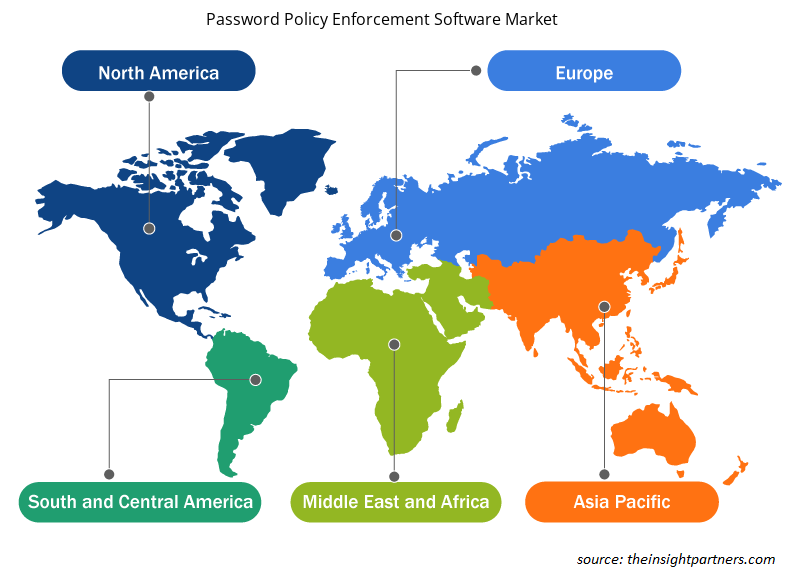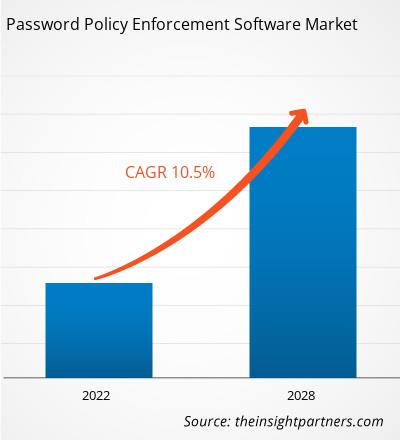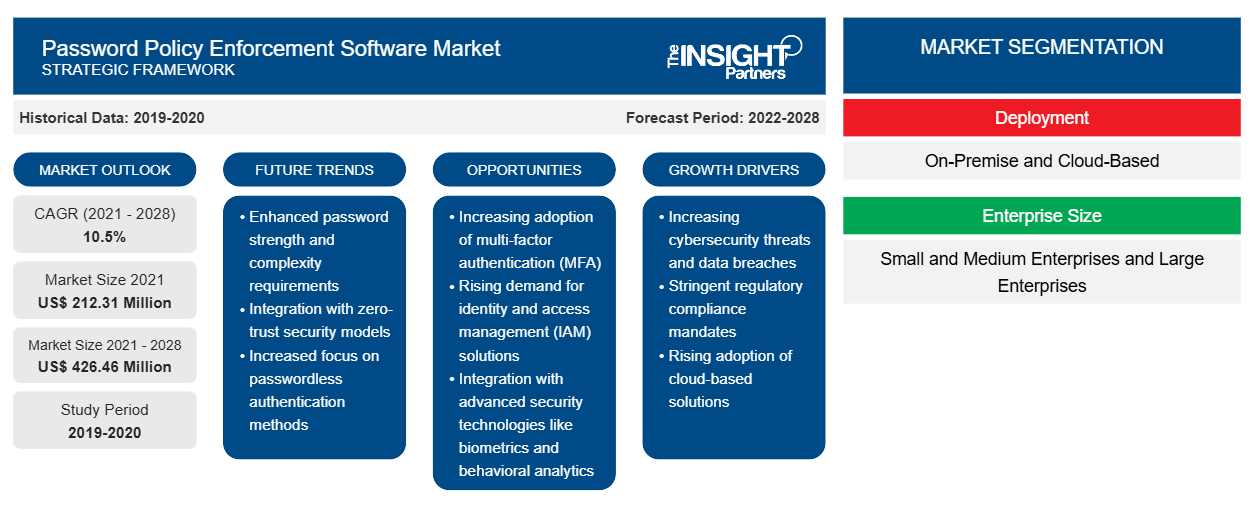Der Markt für Software zur Durchsetzung von Kennwortrichtlinien wurde im Jahr 2021 auf 212,31 Millionen US-Dollar geschätzt und soll bis 2028 426,46 Millionen US-Dollar erreichen. Von 2021 bis 2028 wird ein durchschnittliches jährliches Wachstum von 10,5 % erwartet.
Softwarelösungen zur Durchsetzung von Kennwortrichtlinien stellen sicher, dass auf allen Plattformen eines Unternehmens sichere Kennwörter verwendet werden. Organisationen installieren Software zur Durchsetzung von Kennwortrichtlinien, damit die entsprechenden Benutzer Kennwörter erstellen können, die den Beschränkungen der Kennwortrichtlinien des Unternehmens in Bezug auf Kennwortkomplexität, Symbole, Zahlen, Groß- und Kleinbuchstaben sowie Mindest- und Höchstzeichen entsprechen. Die Beschränkungen stellen außerdem sicher, dass Kennwörter keine häufig verwendeten Wörter, Ausdrücke oder Kennwörter, vom Unternehmen festgelegte Wörter auf der schwarzen Liste oder Kennwörter aus bekannten Hackerwörterbüchern enthalten.
Mehrere digitale Anbieter sind mit vereinfachten Angeboten für verschiedene Branchen in den Markt für Software zur Durchsetzung von Kennwortrichtlinien eingestiegen . So bietet beispielsweise die Netwrix Corporation vereinfachte Software zur Durchsetzung von Kennwortrichtlinien an, die selbst die kompliziertesten Anforderungen an Kennwortrichtlinien erfüllt, indem sie Benutzern, Domänengruppen und Organisationseinheiten ermöglicht, bis zu 256 lokale und Domänenkennwortregeln festzulegen.
Nordamerika ist einer der wichtigsten Märkte für Software zur Durchsetzung von Passwortrichtlinien. Darüber hinaus wird erwartet, dass kontinuierliche technologische Verbesserungen in den Bereichen Analytik, Cloud und BYOD-Trends dem regionalen Markt einen großen Aufschwung verleihen. Darüber hinaus hat eine zunehmende Häufigkeit von Cyberangriffen Bedenken hinsichtlich der Passwortsicherheit ausgelöst, was zum Wachstum des Marktes für Software zur Durchsetzung von Passwortrichtlinien beiträgt.
Passen Sie diesen Bericht Ihren Anforderungen an
Sie erhalten kostenlos individuelle Anpassungen an jedem Bericht, einschließlich Teilen dieses Berichts oder einer Analyse auf Länderebene, eines Excel-Datenpakets sowie tolle Angebote und Rabatte für Start-ups und Universitäten.
- Holen Sie sich die wichtigsten Markttrends aus diesem Bericht.Dieses KOSTENLOSE Beispiel umfasst eine Datenanalyse von Markttrends bis hin zu Schätzungen und Prognosen.
Auswirkungen der COVID-19-Pandemie auf den Markt für Software zur Durchsetzung von Kennwortrichtlinien
Die enorme Verbreitung von SARS-CoV-2 veranlasste die Regierungen verschiedener Länder, strenge Beschränkungen für die Bewegung von Fahrzeugen und Menschen zu verhängen. Die daraus resultierenden Reiseverbote, Massensperren und Geschäftsschließungen, die von den Regierungen verhängt wurden, wirkten sich insbesondere im Jahr 2020 auf die Volkswirtschaften und Industrien verschiedener Länder aus. Die verhängten Sperren reduzierten auch die Produktion von Rohstoffen, Waren und Dienstleistungen. Im Gegenteil, die COVID-19-Pandemie trug zum Wachstum des Marktes für Software zur Durchsetzung von Kennwortrichtlinien im Jahr 2020 bei, da Millionen von Mitarbeitern von ihren Unternehmen aufgefordert wurden, von zu Hause aus zu arbeiten. Die Einhaltung solcher standardmäßigen Schutzmaßnahmen hat zu einem Anstieg der Nutzung von Netzwerken, digitalen Plattformen und persönlichen Computergeräten von Drittanbietern geführt. Solche Netzwerkkonnektivitätslösungen erhöhen das Risiko von Datenschutzverletzungen und anderer Malware. Aufgrund des erhöhten Risikos von Cyberkriminalität suchen Unternehmen nach Software zur Durchsetzung von Kennwortrichtlinien, um abnormales Verhalten in den Netzwerken zu erkennen und zu verwalten.
Markteinblicke – Markt für Software zur Durchsetzung von Kennwortrichtlinien
Fortschritte auf dem Markt für Software zur Durchsetzung von Kennwortrichtlinien
Während es einen wachsenden Trend zu alternativen Authentifizierungsmethoden gibt, finden Passwörter eine Lösung, um „koexistieren“ zu können, und Passwörter sind auf absehbare Zeit notwendig. Bevor ausgefeilte Lösungen einfach eingesetzt werden können, müssen vorhandene Passwörter durch neuere Standards wie Biometrie und Multi-Faktor-Authentifizierung ergänzt werden . Die Tatsache, dass Passwörter nicht stark genug sind, um allein zu bestehen, untergräbt nicht ihre Bedeutung in Bezug auf die Sicherheit. Selbst wenn Passwörter auf dem Rückzug sind, sollten Unternehmen also an ihren Richtlinien festhalten und sicherstellen, dass ihre Mitarbeiter eine Passworthygiene praktizieren. Passwörter werden verwendet, um Zugang zu Technologie zu erhalten. Aufgrund von Technologien wie Apples Touch ID hat die passwortlose Bewegung einen technologischen Wendepunkt erreicht: Die Technologie schreitet voran und Kunden wurden auf biometrische Authentifizierung vorbereitet. Die Vorteile passwortloser Setups gehen über physische Formfaktoren hinaus. Benutzer können sich per Gesicht, Berührung oder Stimme identifizieren, aber Systeme können jetzt auch räumliche Kennungen enthalten. Verhaltensanalysen sind schwieriger zu kompromittieren und für den Benutzer weniger umständlich.
Darüber hinaus reagieren Benutzer bei der Implementierung eines neuen Sicherheitssystems immer negativ auf Unbekanntheit oder wahrgenommene Mehrkosten. Zwei-Faktor- und Multi-Faktor-Authentifizierung erfreuen sich jedoch zunehmender Beliebtheit und zahlen sich für diejenigen aus, die sie verwenden. Daher wird erwartet, dass Fortschritte bei der Software zur Durchsetzung von Kennwortrichtlinien das Marktwachstum für Software zur Durchsetzung von Kennwortrichtlinien in naher Zukunft vorantreiben werden.
Bereitstellungsbasierte Einblicke
Basierend auf dem Bereitstellungstyp kann der Markt für Software zur Durchsetzung von Kennwortrichtlinien in On-Premises und Cloud-basierte Software unterteilt werden. In der heutigen IT-Welt von Unternehmen müssen zahlreiche Überlegungen angestellt werden, bevor entschieden wird, ob eine Cloud-Infrastruktur perfekt passt. Andererseits sind viele Unternehmen nicht in der Lage, den Übergang zur Cloud zu vollziehen und verlassen sich stattdessen für ihre Geschäftstätigkeit auf ihre bewährten Legacy- und On-Premise-Systeme und -Software.
Erkenntnisse basierend auf der Unternehmensgröße
Basierend auf der Unternehmensgröße wird der Markt für Software zur Durchsetzung von Kennwortrichtlinien in kleine und mittlere Unternehmen sowie in große Unternehmen unterteilt. Kleine und mittlere Unternehmen (KMU) sind Unternehmen, deren Umsatz, Vermögen oder Personal unter einem bestimmten Schwellenwert liegen. Kleine und mittlere Unternehmen (KMU) werden in jedem Land anders definiert. Trotz ihrer geringen Größe spielen KMU eine wichtige Rolle in der Wirtschaft. Sie sind deutlich zahlreicher als Großkonzerne, beschäftigen eine riesige Belegschaft und sind unternehmerisch tätig, was zur Gestaltung von Innovationen beiträgt.
Regionale Einblicke in den Markt für Software zur Durchsetzung von Kennwortrichtlinien
Die regionalen Trends und Faktoren, die den Markt für Software zur Durchsetzung von Kennwortrichtlinien während des gesamten Prognosezeitraums beeinflussen, wurden von den Analysten von Insight Partners ausführlich erläutert. In diesem Abschnitt werden auch Marktsegmente und Geografie für Software zur Durchsetzung von Kennwortrichtlinien in Nordamerika, Europa, im asiatisch-pazifischen Raum, im Nahen Osten und Afrika sowie in Süd- und Mittelamerika erörtert.

- Erhalten Sie regionale Daten zum Markt für Software zur Durchsetzung von Kennwortrichtlinien
Umfang des Marktberichts zur Durchsetzung von Kennwortrichtlinien
| Berichtsattribut | Details |
|---|---|
| Marktgröße im Jahr 2021 | 212,31 Millionen US-Dollar |
| Marktgröße bis 2028 | 426,46 Millionen US-Dollar |
| Globale CAGR (2021 - 2028) | 10,5 % |
| Historische Daten | 2019-2020 |
| Prognosezeitraum | 2022–2028 |
| Abgedeckte Segmente | Nach Bereitstellung
|
| Abgedeckte Regionen und Länder | Nordamerika
|
| Marktführer und wichtige Unternehmensprofile |
|
Dichte der Marktteilnehmer für Software zur Durchsetzung von Kennwortrichtlinien: Die Auswirkungen auf die Geschäftsdynamik verstehen
Der Markt für Software zur Durchsetzung von Kennwortrichtlinien wächst rasant. Dies wird durch die steigende Nachfrage der Endbenutzer aufgrund von Faktoren wie sich entwickelnden Verbraucherpräferenzen, technologischen Fortschritten und einem größeren Bewusstsein für die Vorteile des Produkts vorangetrieben. Mit der steigenden Nachfrage erweitern Unternehmen ihr Angebot, entwickeln Innovationen, um die Bedürfnisse der Verbraucher zu erfüllen, und nutzen neue Trends, was das Marktwachstum weiter ankurbelt.
Die Marktteilnehmerdichte bezieht sich auf die Verteilung der Firmen oder Unternehmen, die in einem bestimmten Markt oder einer bestimmten Branche tätig sind. Sie gibt an, wie viele Wettbewerber (Marktteilnehmer) in einem bestimmten Marktraum im Verhältnis zu seiner Größe oder seinem gesamten Marktwert präsent sind.
Die wichtigsten Unternehmen auf dem Markt für Software zur Durchsetzung von Kennwortrichtlinien sind:
- VerwaltenEngine
- Avatier
- Hitachi ID Systems Inc.
- Netwrix Corporation
- nFront Security Inc.
Haftungsausschluss : Die oben aufgeführten Unternehmen sind nicht in einer bestimmten Reihenfolge aufgeführt.

- Überblick über die wichtigsten Akteure auf dem Markt für Software zur Durchsetzung von Kennwortrichtlinien
Die Akteure auf dem Markt für Software zur Durchsetzung von Kennwortrichtlinien konzentrieren sich hauptsächlich auf die Entwicklung fortschrittlicher und effizienter Produkte.
- Im Jahr 2021 erwarb Netwrix PolicyPak, um sein Angebot um Endpunktsicherheit zu erweitern. Diese Übernahme soll das Produktportfolio von Netwrix stärken und die Sicherheit und Kontrolle über privilegierte Konten in den kommenden Jahren auf Desktops ausweiten. PolicyPak und Netwrix bieten gemeinsam Lösungen für Organisationen zur Sicherheit gegen Cyberangriffe und Hacker.
- Im September 2020 gab ManageEngine bekannt, dass ADSelfService Plus jetzt die Multi-Faktor-Authentifizierung unterstützt, um Organisationen vor unbefugtem Zugriff auf ihre Daten zu schützen.
Globaler Markt für Software zur Durchsetzung von Kennwortrichtlinien – Unternehmensprofile
- Avatier
- Hitachi ID Systems, Inc.
- Netwrix Corporation
- nFront Security, Inc.
- safepass.me
- Specops Software
- Tools4ever (Passwortkomplexitäts-Manager (PCM))
- Zoho Corp (ManageEngine)
- JumpCloud Inc.
- Enzoisch.
- Historische Analyse (2 Jahre), Basisjahr, Prognose (7 Jahre) mit CAGR
- PEST- und SWOT-Analyse
- Marktgröße Wert/Volumen – Global, Regional, Land
- Branchen- und Wettbewerbslandschaft
- Excel-Datensatz
Aktuelle Berichte
Verwandte Berichte
Erfahrungsberichte
Grund zum Kauf
- Fundierte Entscheidungsfindung
- Marktdynamik verstehen
- Wettbewerbsanalyse
- Kundeneinblicke
- Marktprognosen
- Risikominimierung
- Strategische Planung
- Investitionsbegründung
- Identifizierung neuer Märkte
- Verbesserung von Marketingstrategien
- Steigerung der Betriebseffizienz
- Anpassung an regulatorische Trends





















 Kostenlose Probe anfordern für - Markt für Software zur Durchsetzung von Kennwortrichtlinien
Kostenlose Probe anfordern für - Markt für Software zur Durchsetzung von Kennwortrichtlinien